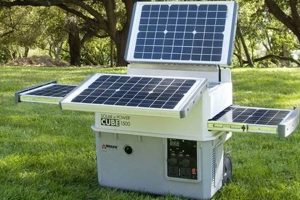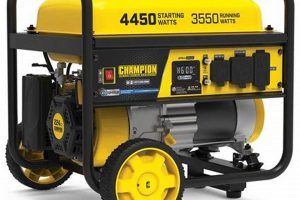Generators integrated into vehicles offer a substantial power advantage compared to smaller, transportable alternatives. This stems from their ability to house larger engines and more robust alternators, facilitated by the ample space and structural support provided by the vehicle frame. For instance, a truck-mounted generator could readily power a construction site, while a portable unit might only suffice for smaller tools or emergency home power.
This increased power capacity has significant implications across various sectors. From disaster relief and emergency services requiring high-output power for extended periods, to industrial applications demanding reliable on-site power in remote locations, vehicle-based systems offer crucial advantages. Historically, portable units were the primary solution for mobile power. However, as technology advanced and the need for greater power output grew, integrating generators directly into vehicles became a more effective solution.
This enhanced power capability naturally leads to discussions regarding optimal generator selection, vehicle integration methods, power management systems, and the diverse applications empowered by this technology. These topics will be explored further in the following sections.
Tips for Utilizing High-Output Vehicle-Based Generators
Effective use of larger, vehicle-integrated generators requires careful planning and consideration. The following tips offer guidance for maximizing their benefits while ensuring safe and efficient operation.
Tip 1: Properly Match Generator Output to Power Requirements. Accurately assess the total power demands of the intended application. Overloading a generator can lead to system failure and potential safety hazards. Consulting load charts and electrical professionals is recommended.
Tip 2: Prioritize Routine Maintenance. Regular maintenance, including oil changes, filter replacements, and system inspections, is crucial for optimal generator performance and longevity. Adhering to manufacturer-recommended maintenance schedules is essential.
Tip 3: Ensure Adequate Ventilation. Generators produce exhaust fumes and require sufficient airflow for cooling. Operate generators in well-ventilated areas and maintain proper clearances around the vehicle.
Tip 4: Implement Proper Grounding Procedures. Correct grounding is paramount for electrical safety. Consult relevant electrical codes and standards to ensure proper grounding techniques are followed.
Tip 5: Consider Fuel Efficiency. Larger generators consume more fuel. Selecting a fuel-efficient model and employing power management strategies can minimize operational costs.
Tip 6: Invest in Surge Protection. Power surges can damage sensitive equipment connected to the generator. Employing surge protectors safeguards against voltage fluctuations.
Tip 7: Plan for Fuel Storage and Handling. Safe and efficient fuel storage is essential. Utilize approved containers and follow recommended fuel handling procedures.
By adhering to these guidelines, users can maximize the benefits of vehicle-mounted generators while minimizing risks and optimizing operational efficiency. This proactive approach ensures reliable power delivery and extends the lifespan of the equipment.
By understanding these key factors, informed decisions regarding power generation solutions can be made. The following conclusion summarizes the advantages and considerations discussed throughout this article.
1. Higher Output
The superior power output of vehicle-mounted generators compared to portable units is a defining characteristic, enabling a wider range of applications and enhanced operational capabilities. This advantage stems from the capacity to integrate larger engines and more robust electrical components within the vehicle’s framework. Examining specific facets of this higher output reveals its practical implications.
- Powering Demanding Equipment
Vehicle-mounted generators can power heavy-duty equipment such as welding machines, large pumps, and industrial lighting systems that typically exceed the capacity of portable generators. This capability is essential in construction, emergency response, and remote operations where access to high power is critical. For example, a vehicle-mounted generator could readily power a mobile field hospital, while a portable unit might only suffice for basic lighting and ventilation.
- Supporting Multiple Devices Simultaneously
The higher output allows simultaneous operation of numerous devices without performance degradation. This is crucial in scenarios requiring diverse power needs, such as a mobile command center supporting communications equipment, computers, and lighting concurrently. This eliminates the need for multiple smaller generators, streamlining operations and reducing logistical complexity.
- Facilitating Faster Operation
In applications like construction, higher power translates to faster completion times. Powering larger tools and machinery at full capacity accelerates tasks such as concrete pouring or excavation. This increased efficiency reduces project timelines and operational costs.
- Enabling Grid Independence
Higher output systems can provide substantial power for extended durations, reducing reliance on traditional power grids. This is particularly relevant in remote areas or disaster-stricken regions where grid access is unavailable or unreliable. This self-sufficiency enhances operational flexibility and resilience.
These facets underscore the significant advantages of higher output offered by vehicle-integrated generators. This enhanced capability expands the potential applications, improves efficiency, and provides greater operational flexibility compared to portable alternatives, ultimately contributing to a more robust and reliable power solution across diverse sectors.
2. Increased Runtime
Extended operational runtime is a direct consequence of the larger fuel capacity and inherent efficiency often associated with vehicle-integrated generators. While greater power output is a key differentiator, the ability to sustain that output for prolonged periods is equally crucial. This extended runtime stems from a combination of factors. Larger fuel tanks, a standard feature in vehicle-mounted systems, eliminate the frequent refueling required by smaller, portable units. Furthermore, the optimized engine operation within these larger systems contributes to better fuel efficiency, extending operational duration on a single tank. Consider a disaster relief scenario: a vehicle-mounted generator can power essential communication equipment and medical devices for days, while a portable unit might require refueling every few hours, disrupting critical operations.
The practical significance of increased runtime is readily apparent in numerous applications. In remote areas, where fuel resupply is challenging, extended operation is paramount. For continuous operations, such as powering a construction site over several days, the reduced downtime for refueling translates to increased productivity and cost savings. Moreover, in emergency situations requiring uninterrupted power, like powering life-support equipment, the reliability and extended runtime offered by vehicle-mounted generators become truly indispensable. Imagine a remote research station relying on a vehicle-mounted generator for power; extended runtime ensures continuous data collection and operational continuity, irrespective of logistical challenges associated with fuel delivery.
In conclusion, the increased runtime associated with vehicle-integrated generators is not merely a byproduct of increased fuel capacity, but a critical performance advantage. This capability significantly enhances operational efficiency, reduces logistical burdens, and provides essential reliability in diverse applications, from remote operations and disaster relief to continuous industrial processes. Understanding the interplay between power output, fuel efficiency, and runtime is essential for selecting the optimal power generation solution for any given application, highlighting the advantages of vehicle-mounted systems in demanding scenarios.
3. Greater Fuel Capacity
Greater fuel capacity is intrinsically linked to the enhanced power delivery and extended operational capabilities of vehicle-mounted generators compared to portable alternatives. The physical size and structural integration of vehicle-mounted systems allow for significantly larger fuel tanks. This increased capacity directly correlates with longer operational periods without refueling, a crucial advantage in various applications. Understanding the multifaceted implications of this increased fuel capacity is essential for appreciating the overall superiority of vehicle-mounted systems in demanding power generation scenarios.
- Extended Operational Time
The most direct benefit of larger fuel tanks is the ability to operate for extended periods without interruption. This is crucial in remote locations, disaster relief efforts, and continuous operations where refueling is logistically challenging or impractical. For example, a vehicle-mounted generator powering a remote communications tower can operate for days or even weeks without refueling, ensuring uninterrupted service in critical situations. Conversely, a portable generator might require frequent refueling, potentially disrupting essential communications.
- Reduced Logistical Burden
Less frequent refueling translates to a reduced logistical burden, particularly in remote or challenging environments. Fewer fuel deliveries mean lower transportation costs, decreased manpower requirements, and minimized environmental impact associated with fuel transport. This is particularly relevant in military operations, oil and gas exploration, and large-scale events where fuel logistics can be complex and costly.
- Enhanced Reliability and Continuity
Continuous operation without interruption is paramount in many applications, particularly those involving essential services or critical infrastructure. Greater fuel capacity contributes directly to enhanced reliability and operational continuity, minimizing downtime and ensuring consistent power delivery. Consider a hospital relying on backup power during a grid outage; a vehicle-mounted generator with a large fuel tank can provide uninterrupted power for extended periods, ensuring critical life-support systems remain operational.
- Support for Higher Power Output
Larger fuel tanks are not merely about extended runtime; they also support the higher power output capabilities of vehicle-mounted generators. Higher output engines naturally consume more fuel. The increased fuel capacity ensures these powerful systems can operate at peak performance for extended periods, maximizing their effectiveness in demanding applications such as powering large-scale construction equipment or supporting mobile command centers during emergencies.
In summary, greater fuel capacity is a key factor contributing to the overall effectiveness and practicality of vehicle-mounted generators in a wide range of applications. By reducing logistical burdens, enhancing reliability, and supporting higher power output over extended periods, this feature underscores the advantages of vehicle-integrated systems compared to portable alternatives. This capability is essential for ensuring mission-critical operations continue uninterrupted in challenging and demanding environments, solidifying the role of vehicle-mounted generators as robust and reliable power solutions.
4. Enhanced Stability
Enhanced stability is a crucial advantage of vehicle-mounted generators, directly influencing their superior performance and reliability compared to portable units. The secure mounting and integration within a vehicle’s frame provide a stable platform for operation, minimizing vibrations and ensuring consistent power delivery, even in challenging environments. This inherent stability contributes significantly to the overall effectiveness and longevity of the generator system. The following facets explore the key components, real-world examples, and practical implications of this enhanced stability.
- Reduced Vibration and Noise
Secure mounting within a vehicle’s frame significantly reduces vibration and noise compared to portable generators, which often operate on uneven terrain or temporary stands. Reduced vibration minimizes wear and tear on internal components, extending the generator’s lifespan. Lower noise levels are crucial in noise-sensitive environments such as residential areas, hospitals, or film sets. For instance, a vehicle-mounted generator powering a mobile medical unit provides stable, quiet power, crucial for patient care and sensitive medical equipment.
- Protection from Environmental Factors
Integration within a vehicle offers protection from the elements, including rain, snow, and dust, which can adversely affect portable generators. This protection enhances reliability and reduces maintenance requirements, particularly in challenging environments. Consider a vehicle-mounted generator powering a construction site in harsh weather conditions; its integrated design ensures continuous operation, minimizing project delays. Conversely, a portable generator might require additional protective measures or experience performance issues due to exposure.
- Improved Safety and Security
The secure mounting of vehicle-integrated generators reduces the risk of accidental displacement or damage, enhancing overall safety. Furthermore, the enclosure within a vehicle provides a degree of security against theft or vandalism, a significant concern with portable units, especially in remote or unsupervised locations. For example, a vehicle-mounted generator used for security surveillance is less vulnerable to tampering compared to a portable unit, ensuring continuous operation and enhanced security.
- Facilitates Integrated Power Management
The fixed position and stable platform facilitate integrated power management systems and connections to the vehicle’s electrical system. This integration allows for streamlined power distribution, automated controls, and improved overall efficiency. This is particularly relevant in specialized vehicles like mobile command centers or broadcast vans where seamless power integration is crucial for complex operations.
The enhanced stability offered by vehicle-mounted generators translates directly to improved reliability, reduced maintenance, and enhanced safety, distinguishing them from portable alternatives. These factors, combined with increased power output and extended runtime, solidify the position of vehicle-mounted systems as robust and versatile power solutions in a wide range of demanding applications. By understanding the multifaceted benefits of enhanced stability, informed decisions regarding power generation solutions can be made, particularly in scenarios requiring reliable and continuous operation in challenging environments.
5. Versatile Applications
The inherent advantages of vehicle-mounted generators, primarily their higher power output, extended runtime, and enhanced stability, directly translate to a wide range of versatile applications across diverse sectors. This versatility distinguishes them significantly from portable generators, which are often limited by their lower power capacity and portability constraints. The connection between increased power capabilities and versatile applications is a defining characteristic of vehicle-mounted systems. This relationship is evident in scenarios requiring high power output in remote locations, continuous operation for extended periods, and stable power delivery in challenging environments.
Consider the following examples: In disaster relief efforts, vehicle-mounted generators can power essential communication systems, medical equipment, and temporary shelters, providing critical support in areas with damaged infrastructure. Their mobility allows rapid deployment to affected areas, while their higher power output ensures sufficient capacity for diverse needs. In the construction industry, these generators power heavy-duty tools and machinery, facilitating efficient project completion, even in remote locations without grid access. The extended runtime minimizes downtime associated with refueling, maximizing productivity. For mobile operations, such as broadcasting or surveillance, vehicle-mounted generators offer a reliable and stable power source, essential for powering sensitive equipment and maintaining continuous operation. The integration within the vehicle simplifies logistics and ensures consistent performance in various environments. Furthermore, in military applications, these generators provide power for critical communication systems, field hospitals, and other essential equipment, supporting operations in remote and challenging terrains. Their robust design and enhanced stability ensure reliable performance under demanding conditions.
The versatility of vehicle-mounted generators stems directly from their enhanced power capabilities, allowing them to fulfill diverse roles across various industries. Understanding this connection is crucial for selecting appropriate power solutions tailored to specific operational needs. While portable generators serve a purpose for smaller-scale applications, the versatility of vehicle-mounted systems positions them as indispensable tools in demanding scenarios requiring high power output, extended operation, and reliable performance in diverse environments. Their capacity to adapt to various applications underscores their value in disaster relief, construction, mobile operations, military applications, and other critical sectors, solidifying their role as robust and adaptable power solutions.
Frequently Asked Questions
This section addresses common inquiries regarding the advantages and considerations associated with generators integrated into vehicles, offering clarity on their capabilities and suitability for various applications.
Question 1: What are the primary advantages of vehicle-integrated generators over portable units?
Vehicle integration allows for larger engines and alternators, resulting in significantly higher power output. This enables operation of more demanding equipment and supports multiple devices simultaneously. Additionally, increased fuel capacity extends operational runtime, minimizing downtime associated with refueling.
Question 2: Are there specific applications where vehicle-mounted generators are particularly beneficial?
Applications requiring high power output, extended runtime, and reliable operation in challenging environments benefit significantly from vehicle-integrated generators. These include disaster relief, construction, mobile command centers, remote area power supply, and military operations.
Question 3: What factors should be considered when selecting a vehicle-mounted generator?
Key considerations include required power output, anticipated runtime needs, fuel type and efficiency, available mounting space and vehicle compatibility, and specific application requirements, such as noise levels or environmental protection.
Question 4: How do maintenance requirements differ between vehicle-mounted and portable generators?
While both require routine maintenance like oil changes and filter replacements, vehicle-mounted generators often benefit from integrated systems monitoring and easier access points, potentially simplifying maintenance procedures. However, integration with the vehicle’s systems may require specialized expertise for certain maintenance tasks.
Question 5: What are the typical costs associated with vehicle-mounted generators compared to portable units?
Vehicle-mounted generators typically represent a higher initial investment due to larger components and integration costs. However, their enhanced performance, extended lifespan, and reduced operational downtime can contribute to long-term cost savings compared to managing multiple portable units or experiencing disruptions due to limited power capacity.
Question 6: How does the fuel efficiency of vehicle-mounted generators compare to portable units?
While larger engines generally consume more fuel, vehicle-mounted generators often incorporate advanced engine management systems and optimized operation, potentially achieving comparable or even better fuel efficiency than smaller, less sophisticated portable units, especially under heavy load.
Understanding these key aspects allows for informed decisions regarding power generation solutions tailored to specific needs. Careful consideration of power requirements, operational demands, and long-term cost implications is crucial for maximizing the benefits of vehicle-mounted generators.
The subsequent section delves into the technical specifications and selection criteria for vehicle-mounted generators, providing further guidance for choosing the appropriate system for specific applications.
Conclusion
This exploration has highlighted the significant power disparity between vehicle-mounted and portable generators. The capacity for increased power output, stemming from larger engines and robust alternators housed within vehicle frames, translates to practical advantages across diverse applications. Extended operational runtimes, facilitated by larger fuel tanks, reduce downtime associated with refueling. Enhanced stability, a result of secure mounting within the vehicle, ensures reliable power delivery even in challenging environments. These combined advantages position vehicle-mounted generators as a superior solution for applications demanding high power, prolonged operation, and consistent performance.
Careful consideration of power requirements and operational demands is essential when selecting a generator solution. While portable units offer convenience for smaller-scale needs, the substantial power advantage of vehicle-mounted generators makes them indispensable for demanding applications requiring robust and reliable power delivery. Understanding these distinctions empowers informed decision-making, ensuring optimal power solutions for diverse operational needs and contributing to enhanced efficiency and productivity across various sectors.






